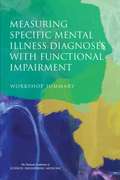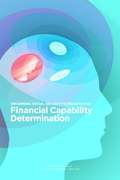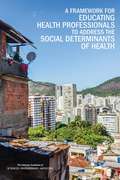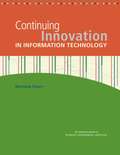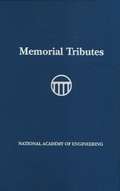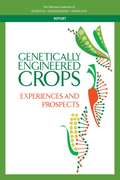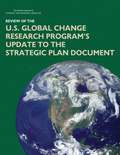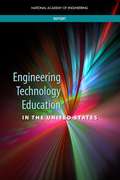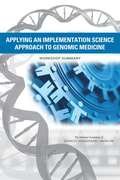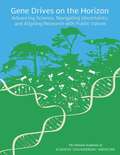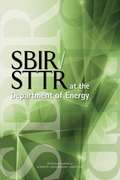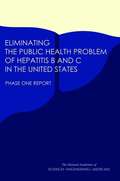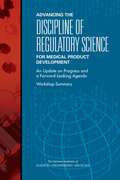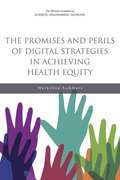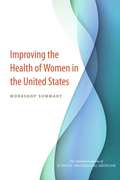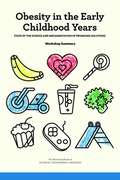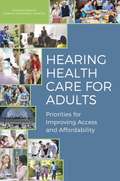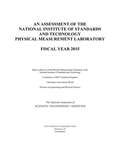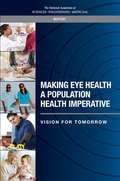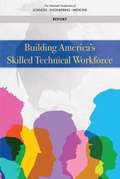- Table View
- List View
Measuring Specific Mental Illness Diagnoses with Functional Impairment: Workshop Summary
by National Academies of Sciences Engineering MedicineThe workshop summarized in this report was organized as part of a study sponsored by the Substance Abuse and Mental Health Services Administration (SAMHSA) and the Office of the Assistant Secretary for Planning and Evaluation of the U.S. Department of Health and Human Services, with the goal of assisting SAMHSA in its responsibilities of expanding the collection of behavioral health data in several areas. The workshop brought together experts in mental health, psychiatric epidemiology and survey methods to facilitate discussion of the most suitable measures and mechanisms for producing estimates of specific mental illness diagnoses with functional impairment. The report discusses existing measures and data on mental disorders and functional impairment, challenges associated with collecting these data in large-scale population-based studies, as well as study design and estimation options.
Commercial Motor Vehicle Driver Fatigue, Long-Term Health, and Highway Safety: Research Needs
by National Academies of Sciences Engineering MedicineThere are approximately 4,000 fatalities in crashes involving trucks and buses in the United States each year. Though estimates are wide-ranging, possibly 10 to 20 percent of these crashes might have involved fatigued drivers. The stresses associated with their particular jobs (irregular schedules, etc.) and the lifestyle that many truck and bus drivers lead, puts them at substantial risk for insufficient sleep and for developing short- and long-term health problems. Commercial Motor Vehicle Driver Fatigue, Long-Term Health and Highway Safety assesses the state of knowledge about the relationship of such factors as hours of driving, hours on duty, and periods of rest to the fatigue experienced by truck and bus drivers while driving and the implications for the safe operation of their vehicles. This report evaluates the relationship of these factors to drivers’ health over the longer term, and identifies improvements in data and research methods that can lead to better understanding in both areas.
Informing Social Security’s Process for Financial Capability Determination
by National Academies of Sciences Engineering MedicineThe U.S. Social Security Administration (SSA) provides benefits to disabled adults and children, offering vital financial support to more than 19 million disabled Americans. Of that group, approximately 5.5 million have been deemed – by virtue of youth or mental or physical impairment - incapable of managing or directing the management of their benefits. Hence, a representative payee has been appointed to receive and disburse SSA payments for these beneficiaries to ensure that their basic needs for shelter, food, and clothing are met. Periodically, however, concerns have been expressed about the accuracy of the process by which SSA determines whether beneficiaries are capable of managing their benefits, with some evidence suggesting that underdetection of incapable recipients may be a particular problem. The importance of creating as accurate a process as possible for incapability determinations is underscored by the consequences of incorrectly identifying recipients either as incapable when they can manage their benefits or as capable when they cannot. Failure to identify beneficiaries who are incapable of managing their funds means abandoning a vulnerable population to potential homelessness, hunger, and disease. Informing Social Security’s Process for Financial Capability Determination considers capability determination processes used by other similar benefit programs, abilities required to manage, and direct the management of, benefits, and effective methods and measures for assessing capability. This report evaluates SSA’s capability determination process for adult beneficiaries and provides recommendations for improving the accuracy and efficiency of the agency’s policy and procedures for making these determinations.
A Framework for Educating Health Professionals to Address the Social Determinants of Health
by National Academies of Sciences Engineering MedicineThe World Health Organization defines the social determinants of health as “the conditions in which people are born, grow, work, live, and age, and the wider set of forces and systems shaping the conditions of daily life.” These forces and systems include economic policies, development agendas, cultural and social norms, social policies, and political systems. In an era of pronounced human migration, changing demographics, and growing financial gaps between rich and poor, a fundamental understanding of how the conditions and circumstances in which individuals and populations exist affect mental and physical health is imperative. Educating health professionals about the social determinants of health generates awareness among those professionals about the potential root causes of ill health and the importance of addressing them in and with communities, contributing to more effective strategies for improving health and health care for underserved individuals, communities, and populations. Recently, the National Academies of Sciences, Engineering, and Medicine convened a workshop to develop a high-level framework for such health professional education. A Framework for Educating Health Professionals to Address the Social Determinants of Health also puts forth a conceptual model for the framework’s use with the goal of helping stakeholder groups envision ways in which organizations, education, and communities can come together to address health inequalities.
Continuing Innovation in Information Technology: Workshop Report
by Engineering Medicine National Academies of SciencesThe 2012 National Research Council report Continuing Innovation in Information Technology illustrates how fundamental research in information technology (IT), conducted at industry and universities, has led to the introduction of entirely new product categories that ultimately became billion-dollar industries. The central graphic from that report portrays and connects areas of major investment in basic research, university-based research, and industry research and development; the introduction of important commercial products resulting from this research; billion-dollar-plus industries stemming from it; and present-day IT market segments and representative U.S. firms whose creation was stimulated by the decades-long research. At a workshop hosted by the Computer Science and Telecommunications Board on March 5, 2015, leading academic and industry researchers and industrial technologists described key research and development results and their contributions and connections to new IT products and industries, and illustrated these developments as overlays to the 2012 "tire tracks" graphic. The principal goal of the workshop was to collect and make available to policy makers and members of the IT community first-person narratives that illustrate the link between government investments in academic and industry research to the ultimate creation of new IT industries. This report provides summaries of the workshop presentations organized into five broad themes - (1) fueling the innovation pipeline, (2) building a connected world, (3) advancing the hardware foundation, (4) developing smart machines, and (5) people and computers - and ends with a summary of remarks from the concluding panel discussion.
Memorial Tributes: Volume 20
by National Academy of EngineeringThis is the 20th Volume in the series Memorial Tributes compiled by the National Academy of Engineering as a personal remembrance of the lives and outstanding achievements of its members and foreign associates. These volumes are intended to stand as an enduring record of the many contributions of engineers and engineering to the benefit of humankind. In most cases, the authors of the tributes are contemporaries or colleagues who had personal knowledge of the interests and the engineering accomplishments of the deceased. Through its members and foreign associates, the Academy carries out the responsibilities for which it was established in 1964. Under the charter of the National Academy of Sciences, the National Academy of Engineering was formed as a parallel organization of outstanding engineers. Members are elected on the basis of significant contributions to engineering theory and practice and to the literature of engineering or on the basis of demonstrated unusual accomplishments in the pioneering of new and developing fields of technology. The National Academies share a responsibility to advise the federal government on matters of science and technology. The expertise and credibility that the National Academy of Engineering brings to that task stem directly from the abilities, interests, and achievements of our members and foreign associates, our colleagues and friends, whose special gifts we remember in this book.
Genetically Engineered Crops: Experiences and Prospects
by Engineering Medicine National Academies of SciencesGenetically engineered (GE) crops were first introduced commercially in the 1990s. After two decades of production, some groups and individuals remain critical of the technology based on their concerns about possible adverse effects on human health, the environment, and ethical considerations. At the same time, others are concerned that the technology is not reaching its potential to improve human health and the environment because of stringent regulations and reduced public funding to develop products offering more benefits to society. While the debate about these and other questions related to the genetic engineering techniques of the first 20 years goes on, emerging genetic-engineering technologies are adding new complexities to the conversation. Genetically Engineered Crops builds on previous related Academies reports published between 1987 and 2010 by undertaking a retrospective examination of the purported positive and adverse effects of GE crops and to anticipate what emerging genetic-engineering technologies hold for the future. This report indicates where there are uncertainties about the economic, agronomic, health, safety, or other impacts of GE crops and food, and makes recommendations to fill gaps in safety assessments, increase regulatory clarity, and improve innovations in and access to GE technology.
Review of the U.S. Global Change Research Program’s Update to the Strategic Plan Document
by National Academies of Sciences Engineering MedicineThe Update to the Strategic Plan (USP) is a supplement to the Ten-Year Strategic Plan of the U.S. Global Change Research Program (USGCRP) completed in 2012. The Strategic Plan sets out a research program guiding thirteen federal agencies in accord with the Global Change Research Act of 1990. This report reviews whether USGCRP’s efforts to achieve its goals and objectives, as documented in the USP, are adequate and responsive to the Nation’s needs, whether the priorities for continued or increased emphasis are appropriate, and if the written document communicates effectively, all within a context of the history and trajectory of the Program.
Engineering Technology Education in the United States
by National Academy of EngineeringThe vitality of the innovation economy in the United States depends on the availability of a highly educated technical workforce. A key component of this workforce consists of engineers, engineering technicians, and engineering technologists. However, unlike the much better-known field of engineering, engineering technology (ET) is unfamiliar to most Americans and goes unmentioned in most policy discussions about the US technical workforce. Engineering Technology Education in the United States seeks to shed light on the status, role, and needs of ET education in the United States.
Applying an Implementation Science Approach to Genomic Medicine: Workshop Summary
by National Academies of Sciences Engineering MedicineAlthough it is becoming increasingly more common for clinicians to use genomic data in their practices for disease prevention, diagnosis, and treatment, the process of integrating genomic data into the practice of medicine has been a slow and challenging one. Some of the major barriers impeding the incorporation of new genomic technology into clinical practice are: the difficulty of changing routine medical practices to account for the use of genetic testing, the limited knowledge of patients and providers about genomic medicine, assessing sufficient evidence to support the use of genetic tests, privacy and data security issues, and uncertainty about reimbursement. The field of implementation science may be able to provide insights concerning efficient ways to incorporate genomic applications into routine clinical practice. The focus of implementation science studies is to identify integration bottlenecks and optimal approaches for a given setting and ultimately to promote the up-take of research findings. To explore the potential of implementation science to improve the integration of genomics into medicine, the National Academies of Sciences, Engineering, and Medicine held a workshop in Washington, DC, in November 2015. Participants explored the challenges and opportunities of integrating genomic advances into the clinic through the lens of implementation science. This report summarizes the presentations and discussions from the workshop.
Gene Drives on the Horizon: Advancing Science, Navigating Uncertainty, and Aligning Research with Public Values
by Engineering Medicine National Academies of SciencesResearch on gene drive systems is rapidly advancing. Many proposed applications of gene drive research aim to solve environmental and public health challenges, including the reduction of poverty and the burden of vector-borne diseases, such as malaria and dengue, which disproportionately impact low and middle income countries. However, due to their intrinsic qualities of rapid spread and irreversibility, gene drive systems raise many questions with respect to their safety relative to public and environmental health. Because gene drive systems are designed to alter the environments we share in ways that will be hard to anticipate and impossible to completely roll back, questions about the ethics surrounding use of this research are complex and will require very careful exploration. Gene Drives on the Horizon outlines the state of knowledge relative to the science, ethics, public engagement, and risk assessment as they pertain to research directions of gene drive systems and governance of the research process. This report offers principles for responsible practices of gene drive research and related applications for use by investigators, their institutions, the research funders, and regulators.
SBIR/STTR at the Department of Energy
by National Academies of Sciences Engineering MedicineThe Small Business Innovation Research (SBIR) program is one of the largest examples of U.S. public-private partnerships, and was established in 1982 to encourage small businesses to develop new processes and products and to provide quality research in support of the U.S. government’s many missions. The Small Business Technology Transfer (STTR) Program was created in 1992 by the Small Business Research and Development Enhancement Act to expand joint venture opportunities for small businesses and nonprofit research institutions by requiring small business recipients to collaborate formally with a research institution. The U.S. Congress tasked the National Research Council with undertaking a comprehensive study of how the SBIR and STTR programs have stimulated technological innovation and used small businesses to meet federal research and development needs, and with recommending further improvements to the programs. In the first round of this study, an ad hoc committee prepared a series of reports from 2004 to 2009 on the SBIR and STTR programs at the five agencies responsible for 96 percent of the programs’ operations -- including the Department of Energy (DoE). Building on the outcomes from the first round, this second round presents the committee’s second review of the DoE SBIR program’s operations. Public-private partnerships like SBIR and STTR are particularly important since today's knowledge economy is driven in large part by the nation's capacity to innovate. One of the defining features of the U.S. economy is a high level of entrepreneurial activity. Entrepreneurs in the United States see opportunities and are willing and able to assume risk to bring new welfare-enhancing, wealth-generating technologies to the market. Yet, although discoveries in areas such as genomics, bioinformatics, and nanotechnology present new opportunities, converting these discoveries into innovations for the market involves substantial challenges. The American capacity for innovation can be strengthened by addressing the challenges faced by entrepreneurs.
Eliminating the Public Health Problem of Hepatitis B and C in the United States: Phase One Report
by National Academies of Sciences Engineering MedicineHepatitis B and C cause most cases of hepatitis in the United States and the world. The two diseases account for about a million deaths a year and 78 percent of world’s hepatocellular carcinoma and more than half of all fatal cirrhosis. In 2013 viral hepatitis, of which hepatitis B virus (HBV) and hepatitis C virus (HCV) are the most common types, surpassed HIV and AIDS to become the seventh leading cause of death worldwide. The world now has the tools to prevent hepatitis B and cure hepatitis C. Perfect vaccination could eradicate HBV, but it would take two generations at least. In the meantime, there is no cure for the millions of people already infected. Conversely, there is no vaccine for HCV, but new direct-acting antivirals can cure 95 percent of chronic infections, though these drugs are unlikely to reach all chronically-infected people anytime soon. This report, the first of two, examines the feasibility of hepatitis B and C elimination in the United States and identifies critical success factors. The phase two report will outline a strategy for meeting the elimination goals discussed in this report.
Evaluation of the Achievement Levels for Mathematics and Reading on the National Assessment of Educational Progress
by National Academies of Sciences Engineering MedicineSince 1969, the National Assessment of Educational Progress (NAEP) has been providing policymakers, educators, and the public with reports on academic performance and progress of the nation’s students. The assessment is given periodically in a variety of subjects: mathematics, reading, writing, science, the arts, civics, economics, geography, U.S. history, and technology and engineering literacy. NAEP is given to representative samples of students across the U.S. to assess the educational progress of the nation as a whole. Since 1992, NAEP results have been reported in relation to three achievement levels: basic, proficient, and advanced. However, the use of achievement levels has provoked controversy and disagreement, and evaluators have identified numerous concerns. This publication evaluates the NAEP student achievement levels in reading and mathematics in grades 4, 8, and 12 to determine whether the achievement levels are reasonable, reliable, valid, and informative to the public, and recommends ways that the setting and use of achievement levels can be improved.
Advancing the Discipline of Regulatory Science for Medical Product Development: Workshop Summary
by National Academies of Sciences Engineering MedicineThe field of endeavors known as “regulatory science” has grown out of the need to link and integrate knowledge within and among basic science research, clinical research, clinical medicine, and other specific scientific disciplines whose focus, aggregation, and ultimate implementation could inform biomedical product development and regulatory decision making. Substantial efforts have been devoted to defining regulatory science and communicating its value and role across the scientific and regulatory ecosystems. Investments are also being made in technology infrastructure, regulatory systems, and workforce development to support and advance this burgeoning discipline. In October 2015, the National Academies of Sciences, Engineering, and Medicine held a public workshop to facilitate dialogue among stakeholders about the current state and scope of regulatory science, opportunities to address barriers to the discipline’s success, and avenues for fostering collaboration across sectors. Participants explored key needs for strengthening the discipline of regulatory science, including considering what are the core components of regulatory science infrastructure to foster innovation in medical product development. This report summarizes the presentations and discussions from the workshop.
The Promises and Perils of Digital Strategies in Achieving Health Equity: Workshop Summary
by National Academies of Sciences Engineering MedicineHealth care is in the midst of a dramatic transformation in the United States. Spurred by technological advances, economic imperatives, and governmental policies, information technologies are rapidly being applied to health care in an effort to improve access, enhance quality, and decrease costs. At the same time, the use of technologies by the consumers of health care is changing how people interact with the health care system and with health information. These changes in health care have the potential both to exacerbate and to diminish the stark disparities in health and well-being that exist among population groups in the United States. If the benefits of technology flow disproportionately to those who already enjoy better coverage, use, and outcomes than disadvantaged groups, heath disparities could increase. But if technologies can be developed and implemented in such a way to improve access and enhance quality for the members of all groups, the ongoing transformation of health care could reduce the gaps among groups while improving health care for all. To explore the potential for further insights into, and opportunities to address, disparities in underserved populations the National Academies of Sciences, Engineering, and Medicine held a workshop in October 2014. The workshop focused on (1) how communities are using digital health technologies to improve health outcomes for racial and ethnic minority populations, (2) how community engagement can improve access to high-quality health information for members of these groups, and (3) on models of successful technology-based strategies to reduce health disparities. This report summarizes the presentations and discussions at the workshop.
Grand Challenges for Engineering: Summary of a Forum
by Steve Olson National Academy of EngineeringEngineering has long gravitated toward great human ambitions: navigation of the oceans, travel to the moon and back, Earth exploration, national security, industrial and agricultural revolutions, communications, and transportation. Some ambitions have been realized, some remain unfulfilled, and some are yet to be determined. In 2008 a committee of distinguished engineers, scientists, entrepreneurs, and visionaries set out to identify the most important, tractable engineering system challenges that must be met in this century for human life as we know it to continue on this planet. For the forum at the National Academy of Engineering's 2015 annual meeting, 7 of the 18 committee members who formulated the Grand Challenges for Engineering in 2008 reflected on what has happened in the seven year since. Grand Challenges for Engineering: Imperatives, Prospects, and Priorities summarizes the discussions and presentations from this forum.
Improving the Health of Women in the United States: Workshop Summary
by National Academies of Sciences Engineering MedicineThe environment for women’s health has changed over the last 25 years. Increased use of automobiles can lead to health risks from lack of physical activity. There has also been an increase in access to and consumption of unhealthy food. Other changes in the past 2 to 3 decades include the significant increase in the number of women who are heads of households and responsible for all aspects of a household and family. Many women now are also having children later in life, which poses interesting issues for both biology and sociology. The growing stress faced by women and the effect of stress on health and illness are issues that need a more comprehensive examination, as do issues of mental health and mental illness, which have been more common and thus increasingly prominent issues for U.S. women. In September 2015, the National Academies of Sciences, Engineering, and Medicine convened a workshop to shed light on important determinants, consequences, effects, and issues attending the relative disadvantage of women in the United States in comparison with women in other economically advanced nations. This report summarizes the presentations and discussions from the workshop.
Ending Discrimination Against People with Mental and Substance Use Disorders: The Evidence for Stigma Change
by National Academies of Sciences Engineering MedicineEstimates indicate that as many as 1 in 4 Americans will experience a mental health problem or will misuse alcohol or drugs in their lifetimes. These disorders are among the most highly stigmatized health conditions in the United States, and they remain barriers to full participation in society in areas as basic as education, housing, and employment. Improving the lives of people with mental health and substance abuse disorders has been a priority in the United States for more than 50 years. The Community Mental Health Act of 1963 is considered a major turning point in America’s efforts to improve behavioral healthcare. It ushered in an era of optimism and hope and laid the groundwork for the consumer movement and new models of recovery. The consumer movement gave voice to people with mental and substance use disorders and brought their perspectives and experience into national discussions about mental health. However over the same 50-year period, positive change in American public attitudes and beliefs about mental and substance use disorders has lagged behind these advances. Stigma is a complex social phenomenon based on a relationship between an attribute and a stereotype that assigns undesirable labels, qualities, and behaviors to a person with that attribute. Labeled individuals are then socially devalued, which leads to inequality and discrimination. This report contributes to national efforts to understand and change attitudes, beliefs and behaviors that can lead to stigma and discrimination. Changing stigma in a lasting way will require coordinated efforts, which are based on the best possible evidence, supported at the national level with multiyear funding, and planned and implemented by an effective coalition of representative stakeholders. Ending Discrimination Against People with Mental and Substance Use Disorders: The Evidence for Stigma Change explores stigma and discrimination faced by individuals with mental or substance use disorders and recommends effective strategies for reducing stigma and encouraging people to seek treatment and other supportive services. It offers a set of conclusions and recommendations about successful stigma change strategies and the research needed to inform and evaluate these efforts in the United States.
Obesity in the Early Childhood Years: Workshop Summary
by National Academies of Sciences Engineering MedicineAmong the many troubling aspects of the rising prevalence of obesity in the United States and elsewhere in recent years, the growth of early childhood overweight and obesity stands out. To explore what is known about effective and innovative interventions to counter obesity in young children, the National Academies of Sciences, Engineering, and Medicine’s Roundtable on Obesity Solutions held a workshop in October 2015. The workshop brought together many of the leading researchers on obesity in young children to describe the state of the science and potential solutions based on that research. Participants explored sustainable collaborations and new insights into the implementation of interventions and policies, particularly those related to nutrition and physical activity, for the treatment and prevention of obesity in young children. Obesity in the Early Childhood Years summarizes the presentations and discussions from the workshop.
Hearing Health Care for Adults: Priorities for Improving Access and Affordability
by National Academies of Sciences Engineering MedicineThe loss of hearing - be it gradual or acute, mild or severe, present since birth or acquired in older age - can have significant effects on one's communication abilities, quality of life, social participation, and health. Despite this, many people with hearing loss do not seek or receive hearing health care. The reasons are numerous, complex, and often interconnected. For some, hearing health care is not affordable. For others, the appropriate services are difficult to access, or individuals do not know how or where to access them. Others may not want to deal with the stigma that they and society may associate with needing hearing health care and obtaining that care. Still others do not recognize they need hearing health care, as hearing loss is an invisible health condition that often worsens gradually over time. In the United States, an estimated 30 million individuals (12.7 percent of Americans ages 12 years or older) have hearing loss. Globally, hearing loss has been identified as the fifth leading cause of years lived with disability. Successful hearing health care enables individuals with hearing loss to have the freedom to communicate in their environments in ways that are culturally appropriate and that preserve their dignity and function. Hearing Health Care for Adults focuses on improving the accessibility and affordability of hearing health care for adults of all ages. This study examines the hearing health care system, with a focus on non-surgical technologies and services, and offers recommendations for improving access to, the affordability of, and the quality of hearing health care for adults of all ages.
An Assessment of the National Institute of Standards and Technology Physical Measurement Laboratory: Fiscal Year 2015
by National Academies of Sciences Engineering MedicineThe Physical Measurement Laboratory (PML) at the National Institute of Standards and Technology (NIST) is dedicated to three fundamental and complementary tasks: (1) increase the accuracy of our knowledge of the physical parameters that are the foundation of our technology-driven society; (2) disseminate technologies by which these physical parameters can be accessed in a standardized way by the stakeholders; and (3) conduct research at both fundamental and applied levels to provide knowledge that may eventually lead to advances in measurement approaches and standards. This report assesses the scientific and technical work performed by the PML and identifies salient examples of accomplishments, challenges, and opportunities for improvement for each of its nine divisions.
Making Eye Health a Population Health Imperative: Vision for Tomorrow
by National Academies of Sciences Engineering MedicineThe ability to see deeply affects how human beings perceive and interpret the world around them. For most people, eyesight is part of everyday communication, social activities, educational and professional pursuits, the care of others, and the maintenance of personal health, independence, and mobility. Functioning eyes and vision system can reduce an adult’s risk of chronic health conditions, death, falls and injuries, social isolation, depression, and other psychological problems. In children, properly maintained eye and vision health contributes to a child’s social development, academic achievement, and better health across the lifespan. The public generally recognizes its reliance on sight and fears its loss, but emphasis on eye and vision health, in general, has not been integrated into daily life to the same extent as other health promotion activities, such as teeth brushing; hand washing; physical and mental exercise; and various injury prevention behaviors. A larger population health approach is needed to engage a wide range of stakeholders in coordinated efforts that can sustain the scope of behavior change. The shaping of socioeconomic environments can eventually lead to new social norms that promote eye and vision health. Making Eye Health a Population Health Imperative: Vision for Tomorrow proposes a new population-centered framework to guide action and coordination among various, and sometimes competing, stakeholders in pursuit of improved eye and vision health and health equity in the United States. Building on the momentum of previous public health efforts, this report also introduces a model for action that highlights different levels of prevention activities across a range of stakeholders and provides specific examples of how population health strategies can be translated into cohesive areas for action at federal, state, and local levels.
Building America’s Skilled Technical Workforce
by National Academies of Sciences Engineering MedicineSkilled technical occupations—defined as occupations that require a high level of knowledge in a technical domain but do not require a bachelor’s degree for entry—are a key component of the U.S. economy. In response to globalization and advances in science and technology, American firms are demanding workers with greater proficiency in literacy and numeracy, as well as strong interpersonal, technical, and problem-solving skills. However, employer surveys and industry and government reports have raised concerns that the nation may not have an adequate supply of skilled technical workers to achieve its competitiveness and economic growth objectives. In response to the broader need for policy information and advice, Building America’s Skilled Technical Workforce examines the coverage, effectiveness, flexibility, and coordination of the policies and various programs that prepare Americans for skilled technical jobs. This report provides action-oriented recommendations for improving the American system of technical education, training, and certification.
State of the Art and Practice in the Assessment of Earthquake-Induced Soil Liquefaction and Its Consequences
by National Academies of Sciences, Engineering, and Medicine Division on Earth and Life Studies Board on Earth Sciences and Resources Committee on State of the Art and Practice in Earthquake Induced Soil Liquefaction AssessmentEarthquake-induced soil liquefaction (liquefaction) is a leading cause of earthquake damage worldwide. Liquefaction is often described in the literature as the phenomena of seismic generation of excess porewater pressures and consequent softening of granular soils. Many regions in the United States have been witness to liquefaction and its consequences, not just those in the west that people associate with earthquake hazards. Past damage and destruction caused by liquefaction underline the importance of accurate assessments of where liquefaction is likely and of what the consequences of liquefaction may be. Such assessments are needed to protect life and safety and to mitigate economic, environmental, and societal impacts of liquefaction in a cost-effective manner. Assessment methods exist, but methods to assess the potential for liquefaction triggering are more mature than are those to predict liquefaction consequences, and the earthquake engineering community wrestles with the differences among the various assessment methods for both liquefaction triggering and consequences. State of the Art and Practice in the Assessment of Earthquake-Induced Soil Liquefaction and Its Consequences evaluates these various methods, focusing on those developed within the past 20 years, and recommends strategies to minimize uncertainties in the short term and to develop improved methods to assess liquefaction and its consequences in the long term. This report represents a first attempt within the geotechnical earthquake engineering community to consider, in such a manner, the various methods to assess liquefaction consequences.
